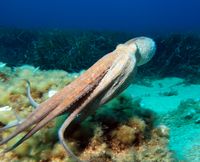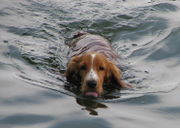Aquatic locomotion
Swimming is biologically propelled motion through a liquid medium. Swimming has evolved a number of times in a range of organisms ranging from arthropods to fish to molluscs.
Contents |
Basic swimming – jellyfish
All jellyfish are free-swimming, although many of these spend most of their time swimming passively. Passive swimming is akin to gliding; the organism floats, using currents where it can, and does not exert any energy into controlling its position or motion. Active swimming, in contrast, involves the expenditure of energy to travel to a desired location.
Swimming in fish
Some fish need to swim in order to maintain flotation; others float naturally by means of swim bladders or other organs. Swimming primarily achieves motion in a certain direction, and the method employed by fish is the most efficient for maintaining a high speed over a significant distance. The same method has been converged upon by cephalopods, who have progressively downplayed the role of jet propulsion in favour of more fish-like swimming.[1]
Jet-propelled swimming

All cephalopods can move by jet propulsion, but this is a very energy-consuming way to travel compared to the tail propulsion used by fish.[2] The relative efficiency of jet propulsion decreases further as animal size increases. Since the Paleozoic, as competition with fish produced an environment where efficient motion was crucial to survival, jet propulsion has taken a back role, with fins and tentacles used to maintain a steady velocity.[3] The stop-start motion provided by the jets, however, continues to be useful for providing bursts of high speed - not least when capturing prey or avoiding predators.[3] Indeed, it makes cephalopods the fastest marine invertebrates,[4]:Preface and they can outaccelerate most fish.[5] Oxygenated water is taken into the mantle cavity to the gills and through muscular contraction of this cavity, the spent water is expelled through the hyponome, created by a fold in the mantle. Motion of the cephalopods is usually backward as water is forced out anteriorly through the hyponome, but direction can be controlled somewhat by pointing it in different directions.[6]
Most cephalopods float (i.e. are neutrally buoyant), so do not need to swim to remain afloat.[2]
Evolution of swimming
Swimming evolved a number of times in unrelated lineages, and the evolutionary pressures leading to its adoption are unknown. Supposed jellyfish fossils occur in the Ediacaran, but the first free-swimming animals appear in the Early to Middle Cambrian. These are mostly related to the arthropods, and include the Anomalocaridids, which swam by means of lateral lobes in a fashion reminiscent of today's cuttlefish. Cephalopods joined the ranks of the nekton in the late Cambrian,[7] and chordates were probably swimming from the Early Cambrian.[8]
Secondary evolution of swimming
While tetrapods lost many of their natural adaptations to swimming when they evolved onto the land, many have re-evolved the ability to swim or have indeed returned to a completely aquatic lifestyle.
Primarily or exclusively aquatic animals have re-evolved from terrestrial tetrapods multiple times: examples include amphibians such as newts, reptiles such as crocodiles, sea turtles, ichthyosaurs, plesiosaurs and mosasaurs, marine mammals such as whales, seals and otters, and birds such as penguins. Many species of snakes are also aquatic and live their entire lives in the water. Many insects swim on a regular basis and some insects, such as certain species of diving beetle, spend most of their time in the water. There are also aquatic spiders, although they tend to prefer other modes of locomotion under water than swimming proper.
Even though primarily terrestrial tetrapods have lost many of their adaptations to swimming, the ability to swim has been preserved or re-developed in many of them. It may never have been completely lost. Examples are:

Some breeds of dog swim recreationally. Umbra, a world record-holding dog, can swim 4 miles (6.4 km) in 73 minutes, placing her in the top 25% in human long-distance swimming competitions[9]. Although most cats hate water, adult cats are good swimmers. The fishing cat is one wild species of cat that has evolved special adaptations for an aquatic or semi-aquatic lifestyle – webbed digits. Tigers and some individual jaguars are the only big cats known to go into water readily, though other big cats, including lions, have been observed swimming. A few domestic cat breeds also like swimming, such as the Turkish Van. In an unpublished research carried out 2002 at the University of Bern (Switzerland), Bender & Hirt showed that the Turkish Van has less inhibition to enter in shallow water compared to another breed, the Russian Blue. This behavior can be partially explained by the character of the Turkish Van, who seems to be more curious and enterprising than other cat breeds (see Widmer 1990).
Horses, moose, and elk are very powerful swimmers, and can travel long distances in the water. Elephants are also capable of swimming, even in deep waters. Eyewitnesses have confirmed that camels, including Dromedary and Bactrian camels, can swim[10], despite the fact that there is little deep water in their natural habitats.
Both domestic and wild rabbits can swim. Domestic rabbits are sometimes trained to swim as a circus attraction. A wild rabbit famously swam in an apparent attack on U.S. President Jimmy Carter's boat when it was threatened in its natural habitat.[11]
The Guinea pig (or cavy) is noted as having an excellent swimming ability.[12] Mice can swim quite well. They do panic when placed in water, but many lab mice are used in the Morris water maze, a test to measure learning. When mice swim, they use their tails like flagella and kick with their legs.
Many snakes are excellent swimmers as well. Large adult anacondas spend the majority of their time in the water, and have difficulty moving on land.
Humans do not swim instinctively, but nonetheless often feel attracted to water, showing a broader range of swimming movements than other non-aquatic animals.[13] In contrast, many monkeys can naturally swim and some, like the proboscis monkey, crab-eating macaque, and Rhesus macaque swim regularly.
Large primates other than humans generally do not like to swim. Wild chimpanzees and some gorillas will wade in very shallow water but will make no attempt to cross larger bodies of water. Orangutans don't swim instinctively but will attempt it under pressure or if learned.
Human swimming
Swimming has been known amongst humans since prehistoric times; the earliest record of swimming dates back to Stone Age paintings from around 7,000 years ago. Competitive swimming started in Europe around 1800 and was part of the first modern 1896 Summer Olympics in Athens, though not in a form comparable to the contemporary events. It was not until 1908 that regulations were implemented by the International Swimming Federation to produce competitive swimming.[14]
References
- ↑ doi:10.1111/j.1469-185X.1972.tb00975.x
This citation will be automatically completed in the next few minutes. You can jump the queue or expand by hand - ↑ 2.0 2.1 Wilbur, Karl M.; Clarke, M.R.; Trueman, E.R., eds. (1985), "11: Evolution of Buoyancy and Locomotion in recent cephalopods", The Mollusca, 12. Paleontology and neontology of Cephalopods, New York: Academic Press, ISBN 0-12-728702-7
- ↑ 3.0 3.1 Wilbur, Karl M.; Clarke, M.R.; Trueman, E.R., eds. (1985), The Mollusca, 12. Paleontology and neontology of Cephalopods, New York: Academic Press, ISBN 0-12-728702-7
- ↑ Marion Nixon and J.Z. Young. (2003). The brains and lives of cephalopods. New York: Oxford University Press. ISBN 0-19-852761-6.
- ↑ By Daniel L. Gilbert, William J. Adelman, John M. Arnold Contributor Daniel L. Gilbert, John M. Arnold (1990). Squid as Experimental Animals (illustrated ed.). Springer,. ISBN 9780306435133.
- ↑ Campbell, Reece, & Mitchell, p.612
- ↑ doi: 10.1016/j.palaeo.2008.12.015
This citation will be automatically completed in the next few minutes. You can jump the queue or expand by hand - ↑ doi:10.1038/nature01264
This citation will be automatically completed in the next few minutes. You can jump the queue or expand by hand - ↑ SWIMMING DOG VIDEOS Swimming Background
- ↑ The Straight Dope Mailbag: The Straight Dope Mailbag: Is the camel the only animal that can't swim?
- ↑ News of the Odd - Jimmy Carter Attacked by Killer Rabbit (April 20, 1979)
- ↑ Harkness, John E.; Wagner, Joseph E. (1995). The Biology and Medicine of Rabbits and Rodents. Williams & Wilkins. pp. 30–39. ISBN 0-683-03919-9.
- ↑ Bender, Renato. 1999a. Die evolutionsbiologische Grundlage des menschlichen Schwimmens, Tauchens und Watens: Konvergenzforschung in den Terrestrisierungshypothesen und in der Aquatic Ape Theory. Institut für Sport und Sportwissenschaft, Universität Bern.
- ↑ Kehm, G (2007). Olympic Swimming and Diving:Great Moments in Olympic History. The Rosen Publishing Group. pp. 14. ISBN 1404209700.